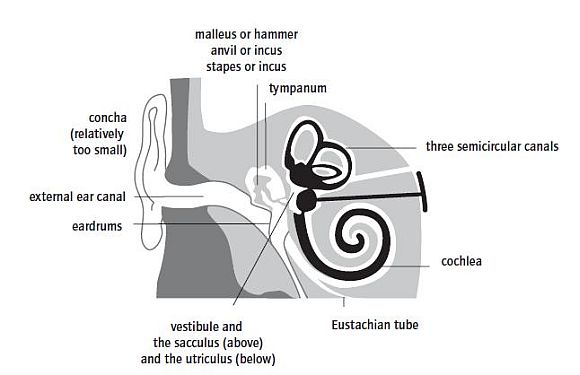
Man is a sun;
and his senses are the planets.
Novalis
Sense of balance
We use our sense of balance to orient ourselves in the world. Observations made with this sense let you know what is up and down, left and right, in front and behind, above and below. The sense of balance perceives the smallest changes in your vertical position.
Your body has a dynamic equilibrium. You maintain your balance by making very small adjustments in muscle tension in muscles all over your body. Every time you stand up you have to rediscover your balance, by using this sense.
Your organ of balance is not the only organ that you use to maintain your balance. Your eyes are at least as important to orient yourself in your surroundings. Your eyes see vertical and horizontal objects which confirm the information given by your organ of balance. Try walking in a room where everything is at odd angles. Your balance could be so distorted, that the surface of the water in a bucket (which is in fact always horizontal) would appear to be sloping downhill.

The organs for balance and hearing
The organ of balance is situated in the petrosal bone and is made up of three semi-circular canals which are perpendicular to each other, and the sacculus and utriculus. The three semi-circular canals are filled with a fluid that moves with every movement of your head, thus registering changes in direction. Because they are at right angles to each other, they can perceive movement in every direction. The sacculus and utriculus perceive the linear position and linear displacement. In the sacculus, a gel-like substance with a calcule made of calcium-carbonate crystals rests on a horizontal layer of sensory cells. During vertical acceleration or deceleration, such as in a lift, the sensory cells detect a change in pressure from the calcule. At constant speed, the pressure on the sensory cells is constant, so you do not notice it. The utriculus also has a calcule, but it is situated against a vertical layer of sensory cells. These cells detect changes in horizontal acceleration, such as when a car accelerates or pulls over. Again, constant speed is not detected.
Together, the three-dimensional planes in the organ of balance cover all the degrees of movement in the joints. Ankle, knee, elbows, shoulder and jaws are in the same plane as the organ of balance.
When you observe other objects, you are using your organ of balance in different ways. First, to determine the position of the object in the surroundings, taking the horizon as your orientation. Secondly, to observe whether something is standing straight up, or leaning, and whether something is actually horizontal or only seems to be. You can detect how far something is out of true. Finally, using your organ of balance you can detect whether something is out of proportion, e.g. whether length is in proportion with height.

The organ of balance and the joints
Exercises
Spin someone around a few times while holding him, and observe his eye movements. Keep holding him after you stop spinning him. What is his balance like after having been spun around? What observations can you make, and what observations did the subject make during and after spinning? How does he perceive his surroundings?
Do this exercise again with another subject, but this time let the subject go after spinning. What observations can you make now?
Blindfold yourself and then try to balance while standing on one leg. Then do it without a blindfold. What is the difference?
Find some trees whose trunks rise almost straight up, but not quite. Observe these trees, and determine what would be the ideal position or angle of the tree-trunk. Repeat this exercise with observations of branches. An excellent tree for this exercise is a mature beech whose branches bend down low to the ground.
Record the length, height and girth of various mammals. How do these measurements relate to each other? Can you make any statements about the harmony of these proportions?
